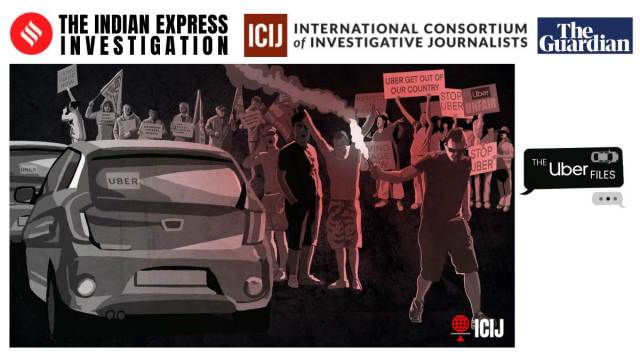- India
- International
Revealed: How Uber took systems for a ride, used its tech to drive past law
We are just f***ing illegal, wrote senior executive after blowback
 These records tell the untold story of how a shaky Silicon Valley start-up became an over $44-billion global transportation giant with operations today in 72 countries – and counting. (Express)
These records tell the untold story of how a shaky Silicon Valley start-up became an over $44-billion global transportation giant with operations today in 72 countries – and counting. (Express)AFTER tracking money flows of the rich into offshore tax havens, it’s now about a tech giant that has, combining business aggression and customer convenience, reshaped cab-hailing across the world: Uber.
In its eighth collaboration with the International Consortium of Investigative Journalists (ICIJ), The Indian Express spent four months investigating The Uber Files, a cache of 124,000 internal emails, text messages and documents from inside Uber.
Obtained by The Guardian and shared with ICIJ and a global consortium of newsrooms in 30 countries, including The Washington Post and BBC, these records tell the untold story of how a shaky Silicon Valley start-up became a $44-billion global transportation giant with operations today in 72 countries — and counting.
And how it used stealth technology to bypass regulators; tapped into a sprawling lobbying network; aggressively cut corners as it drove through loopholes in law and regulation.
These records cover 2013-2017, the period when the company, led by its flamboyant and brash co-founder, Travis Kalanick, was steamrolling its cab-hailing service from one world market to another.

Kalanick has responded to ICIJ’s revelations through his spokesperson, Devon Spurgeon, in his signature style: “When Mr Kalanick co-founded Uber in 2009, he and the rest of the team pioneered an industry that has now become a verb. To do this required a change of the status quo, as Uber became a serious competitor in an industry where competition has been historically outlawed.”
Since it launched services in 2013, Uber found in India one of its fastest growing markets — an estimated 6 lakh drivers plying today in over 100 cities riding on an urban workforce sprawling across cities with spotty public transport and restricted taxi services.
Uber’s strategy was summed up in an email that Uber’s then Asia head, Allen Penn, wrote to the India team in August 2014. “We’ve definitely made a splash in our first year in India…We will likely have both local and national issues in almost every city in India…That’s life running a business at Uber,” he wrote.
Records detail Uber’s run-ins with a host of Indian regulatory authorities, including GST and Income Tax Departments as well as Consumer Forums, the Reserve Bank of India and the Service Tax Department.
Indeed, in September 2014, Uber prepared a presentation for its staff using India as a case study for handling Service Tax issues. “Authorities want Uber to open their books, otherwise we are facilitating fraud,” says a slide in a PowerPoint presentation which is part of the records now revealed.
Shortly after that, in December 2014, crisis hit the company following the rape of a 25-year-old passenger in New Delhi in an Uber car by the driver.
Dozens of internal emails show that even as red flags were being raised on the ban imposed by the Delhi government, top executives squarely blamed the “flawed” licensing systems in India for letting the criminal record of the accused driver slip through.
Uber was in panic and in between some frantic damage control, Nairi Hourdajian, then the head of Uber’s communications unit, wrote in an email to his colleague on December 11, 2014, just six days after the rape: “Remember that everything is not in your control, and that sometimes we have problems because, well, we’re just f***ing illegal.”
An investigation by The Indian Express shows that critical elements of the new safety features that Uber boasted of after the New Delhi rape incident, are not yet in place. Example: the “panic button” that every Uber cab — like public transport buses and cabs — is meant to be fitted with is yet to be integrated with Delhi Police and State Transport Department systems even six years after the rape.
Much has been said about the “nastytech” Uber deployed during Kalanick’s tenure and The Uber Files dramatically expands upon instances and circumstances of its use: there are details of how the company used tools like “greyball” and “ geofencing” to keep Uber rides away from prying policemen and Government officials.
Significantly, there are 13 instances uncovered in the files about deployment of the ‘Kill Switch’ in several countries – an in-house label for a process that shuts down local systems to firewall them from any probe. In fact, in six cases, the records reveal, the ‘Kill Switch’ was used even as raids by regulators were in progress at Uber offices.
One particular email from a top Uber executive of February 2015 (in the context of anticipated tax raids in Belgium) details the modus operandi Uber used for India: how the local team appeared to be cooperative before Indian authorities even as they were actually “shut down” — courtesy the ‘Kill Switch’ — by Uber’s headquarters.
Uber is trying to leave many of these controversies behind and in response to questions sent to the company’s India head, Prabhjeet Singh, its spokesperson responded, “When Uber launched in India almost a decade ago, no ridesharing regulations existed at that time as the transportation laws did not conceive app-based ride sharing as an option. We have long championed rules and regulations that reflect changing technology and interest of cities and our customers — riders and drivers alike. As a category defining company, we applaud and support progressive regulatory change that is good for riders, drivers and cities.’’
Across the world, the Uber Files also underline the almost military precision with which Uber has, over the years, made friends in high places.
The company, with the help of an advisory firm, had prepared a list of more than 1,850 “stakeholders” from different countries, with among whom its top brass could seek meetings. The “stakeholders” were a mixed club: public officials, bureaucrats, members of think tanks and transportation experts.
Among Uber’s “close” friends, the records show, was Emmanuel Macron, who, as a then Minister in France, was clearly identified as an Uber “ally.” There are several exchanges between Macron and key Uber executives, including Kalanick.
The company had also courted oligarchs who had proximity to Russian President Vladimir Putin. Some of the oligarchs who figure in the data have since been sanctioned after the invasion of Ukraine.
Uber hired former Obama aide David Plouffe (he visited India in February 2016 and met three Chief Ministers) as head of the company’s global branding in 2014 and worked there till 2017.
Records show that Plouffe participated in internal email discussions on use of the ‘Kill Switch’ during raids on two occasions.
May 05: Latest News
- 01
- 02
- 03
- 04
- 05





































